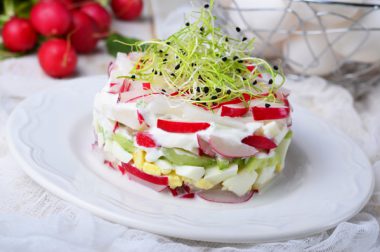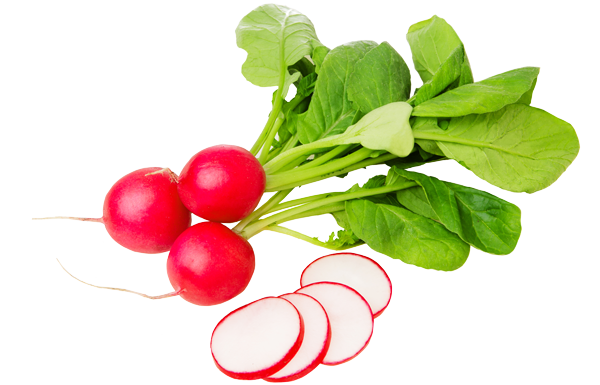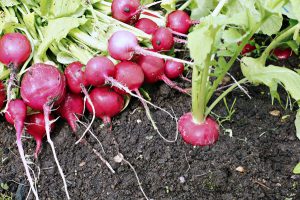Recipes we love
See all recipesAmerican salad with radishes
A nutritionally beneficial combination of vitamins and essential fatty acids, which most people lack...
Goat’s cheese with Speculoos biscuits and radish
Packed with fibre and calcium, you can turn this entrée into a light meal by adding more salad leave...
Black radish salad
If the radishes are very big, cut them into slices and lightly salt to soften. Leave to stand for 30...
Health
benefits
A vegetable that helps with weight loss!
Pink radishes have a high water content and are a natural appetite suppressant, making them ideal starters for a meal. They are low in sodium, high in potassium, and natural diuretics.
Radishes are also:
- a source of vitamin B9 (for cellular renewal, particularly important for pregnant women for fetal development, for growing children, and for convalescents).
- a source of vitamin C (for the immune system, collagen formation, energy, the nervous system, iron absorption, and fatigue reduction)
They also contain:
- potassium
- antioxidants
- glucosinolates (compounds with anticancer properties)
Nutritional
composition
When is the right
time to eat them?
Spring.
Pink radishes are available year-round, but their high season lasts from March to June, a period during which they reach the peak of their flavor and nutritional characteristics.
Vegetable patch
or urban balcony?
Radishes (Raphanus sativus, of the Brassicaceae family) are herbaceous annuals that grow well in light, neutral (pH = 7) soil rich in humus, in sunny spots or partial sun.
To learn everything you need to know about growing radishes, read the page on growing advice.
Choosing and
storing radishes
Choose your radishes well:
- The greens should have a nice green color and the roots should be firm and shiny.
- The younger they are, the weaker the flavor.
- Choose young radishes to eat raw and keep the older ones for dressing with vinegar as a relish, or for cooking.
Properly store your radishes:
- Ideally, radishes should be eaten the same day they are purchased.
- In the refrigerator: Four to five days in the vegetable drawer, in a perforated plastic bag.
Tips and
tricks
Radishes are prepared…
In the blink of an eye! Clean them, then take out the greens and throw away the bottom roots. Serve on a slice of fresh bread with some salt or butter. Done!
Anti-waste tip: Don’t throw away the radish greens. Chop the leaves and add them to soups and omelets. Alternatively, cook them like spinach. You can also make a delicious blended soup by cooking them in a small amount of water or broth with a potato, then thoroughly blending everything once it is cooked.
Although radishes are most often eaten raw, they can also be cooked — but not for too long. Choose methods with fast cooking times, such as frying them in a wok or frying pan, steaming, or grilling/barbecue.
Radishes go well with…
Raw: Fresh cheese and fine herbs, cooked green beans, corn, and cherry tomatoes, all in a multicolored salad, or dipped in hummus, guacamole, eggplant caviar or tapenade, served with fish or roasted chicken, and more.
Cooked: Radish greens go very well with roasted pork meat.
Try this: candied radishes. The principle is the same as for glazed turnips: cut the radishes in a similar fashion, coat them in melted butter at the bottom of a saucepan, add sugar or honey, cover with water, and put the lid on. The radishes will absorb the liquid as they cook, and then melt in your mouth. They go perfectly well with duck breast!
Can everyone
eat them?

Young children
Babies can eat the milder varieties in thin slices starting at 12 months of age.
And everyone else
People with irritable bowel syndrome may have an intolerance to radishes. This intolerance is generally temporary and radishes can be reintroduced into a diet little by little when the symptoms are mild or during remission.
See plenty of other tips for encouraging children to eat vegetables
Where do they come from?
Origins and varieties
Origins: Spain, Greece, Israel, the United States, Italy, France, and the Netherlands are the main producers of radishes. Radishes are traditionally associated with French meals.
Varieties: There are three types of radishes: pink, black, and Daikon.
Pink radishes are small, fleshy roots, elongated or round, white with a light or dark shade of pink or red. There are a great many varieties of pink radishes. The small, two-colored pink radishes, nicknamed “radis de tous les mois” (lit. radishes for every month), can be cultivated year-round, as the many varieties are adapted to various climate conditions. They can be pink, red, elongated, round, pointy, or pink with a pointy white end.
Fall and summer radishes take longer to grow, are bigger, and have a stronger flavor. Winter radishes are sometimes as big as a turnip, with firm, compact flesh and a strong flavor. They keep all winter. In French, the ones with black skin are mistakenly called raifort, or horseradish.
Oriental radishes are bigger and longer than summer radishes. The main varieties are Daikon radishes (which are white), green oriental radishes, and red oriental radishes. The first look like white carrots and their flesh is soft, sweet, and white. Oriental radishes with green skin have firm, strong-flavored flesh. Finally, red oriental radishes, also called watermelon radishes, have green and white skin, sometimes with a bit of pink. By contrast, their flesh is pink or bright red. They are slightly sweet, very crunchy, with a strong flavor.
Black radishes are popular in Eastern Europe and have a strong flavor. Their diameter is between 5 cm and 7 cm (1.9-2.8 in) on average, and they can be up to 15 cm (5.9 in) long. They have rough, black skin and firm, white flesh. These radishes are mainly eaten in winter and are less juicy than summer radishes.



 Onions
Onions  Millet
Millet  Vegetable garden: growing lettuce
Vegetable garden: growing lettuce 










